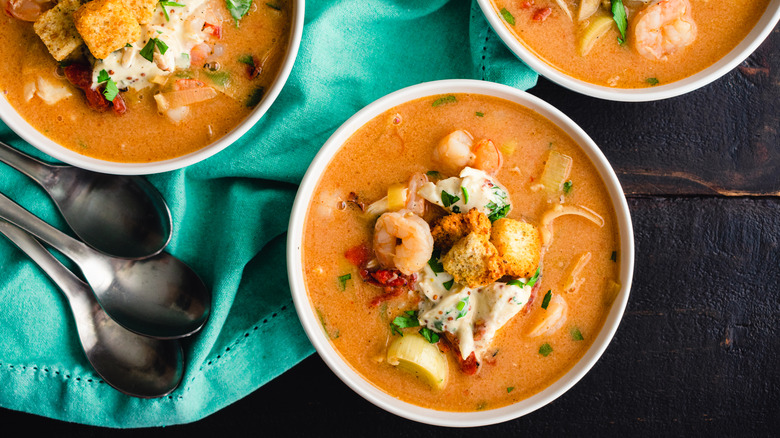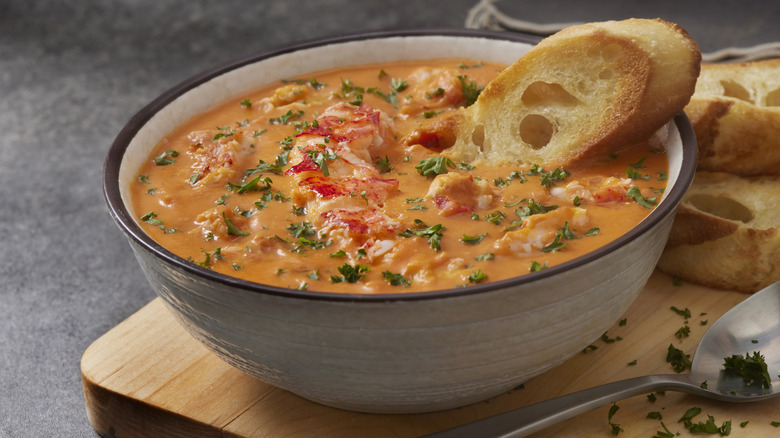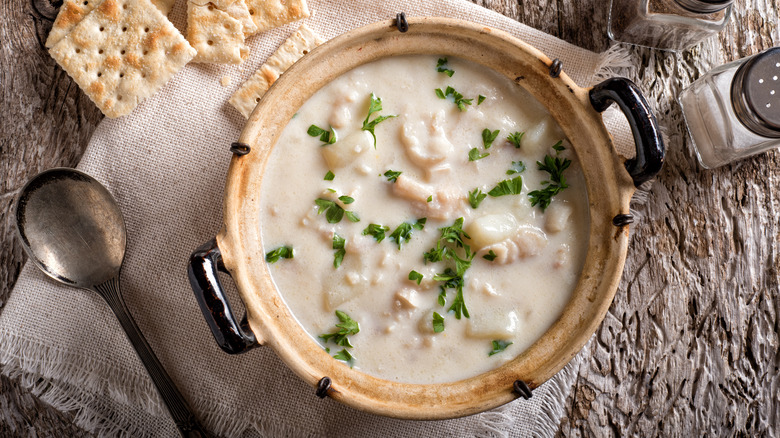The Textural Difference Between Chowder Vs Bisque
Chowder and bisque: They're two sides of the same delicious coin, right? Creamy and thick, both styles of soup have French beginnings (more on that later) and tend to be made with seafood, although this isn't always the case — just try a Cajun-style corn chowder for a life-changing experience. Regardless of their similarities, however, chowder and bisque actually share one major difference: texture.
While bisque's base is smooth and silky thanks to the necessary step of pureeing, a chowder is chunky, with ingredients like potatoes, vegetables, and seafood floating around and mimicking a stew, even a little more than it mimics a soup. Bisque can have chunks of seafood in it — like a lobster bisque — but the difference here is that the meat is usually cooked separately and then added to the pureed bisque (or even spooned on top of each serving bowl). Regardless of which one you end up ordering or making at home, you'll have a bowl of something delicious, creamy, and warm to obsess over.
What is bisque?
While all bisques are considered a soup, not all soups can call themselves a velvety, flavor-packed bisque. With roots in France that can be traced back to the 17th century, the first iteration was likely made with crayfish, though some circles say that the first was actually made with pigeon meat. While the most popular version is the beloved lobster bisque, you can find varieties made with various types of crustaceans, including shrimp and crab, and some with different veggies, like tomatoes or butternut squash.
For many bisques, crustacean shells can help deepen the flavor of the broth, either by sauteeing them or crushing them up to create a paste, while rice is often used as a thickener. Additionally, cream can help create that signature smooth texture along with your favorite blender to puree everything. We recommended using an immersion blender here so that you don't have to risk burning yourself when you spoon your broth into a standing blender. If you only have a standing blender, just make sure the bisque cools down a bit before adding to the blender so you don't cause a hot-soup explosion.
What is chowder?
Chowder can be traced back to 16th century French fishing villages. At that time, fishermen would return from sea to celebratory potlucks where families would make big, thick fish stews that included vegetables, spices, potatoes, and whatever the fishermen caught. Eventually, the tradition of fish stew made its way to North America and was dubbed chowder (taken from the French word chaudière, that described the large pot or cauldron that the fish stews were made in).
Today, the most popular chowders are found in the Northeast and are still made of seafood (like New England and Manhattan clam chowders), although there are tons of different kinds that can appease any palate (like sweet corn and cashew chowder).
Like bisques, chowders are typically made with a cream base, other than Manhattan clam chowder, which has a tomato base. What shines in a chowder, though, are the hearty chunks of potatoes and veggies that are simmered in the broth to add textural elements and deep, rich flavor. No matter which one you make, both chowders and bisques are the perfect kinds of soup to add to a bread bowl thanks to their thick consistencies that won't make a mushy mess.



